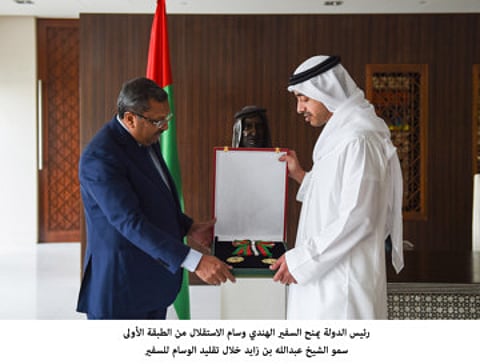UAE, India share winning ties
Despite a reduced trade balance, the UAE and India are committed to strengthening their bilateral relationship

India’s 70th Independence Day comes at a landmark stage in the country’s relations with the UAE. The trade balance between the two nations for the financial year 2015-16 might shrink by nearly $11 billion (about Dh40.4 billion), but this is expected to be a mere hiccup amidst larger global economic factors, and the countries are making great strides to stimulate growth. This forms part of a bigger strategy to increase bilateral cooperation.
Embassy data cites the Indian Department of Commerce (DoC) projecting trade between India and the UAE to fall by almost 16 per cent to $49.72 billion over 2014-15, likely due to lower oil prices. Indian exports are expected to total $30.3 billion. Jewellery including pearls, precious or semi-precious stones and metals are showing positive growth to $12.95 billion, contributing the biggest share. This is followed by the mineral fuels sector, which is down to $3.97 billion. Imports from the UAE are expected to contract from $26.13 billion to about $19.42 billion. The oil sector shows the biggest decrease at $7.89 billion from $13.5 billion.
Intent on growth
However, in a joint statement during the first state visit of His Highness Shaikh Mohammad Bin Zayed Al Nahyan, Crown Prince of Abu Dhabi and Deputy Supreme Commander of the UAE Armed Forces, to India in February, the two nations reaffirmed their resolve to work together to increase trade by 60 per cent over the next five years, as agreed during Prime Minister Narendra Modi’s visit to the UAE last year.
Other areas, including scientific research and security, will also receive attention. “In the area of defence cooperation, the two sides renewed their commitment to strengthening the existing cooperation in training, joint exercises and participation in defence exhibitions, as well as in identifying opportunities to cooperate on the production of defence equipment in India,” said the statement.
According to national news agency WAM, an Emirati-Indian parliamentary committee is also in the works, with exchange visits to promote parliamentary cooperation between the two nations on political, economic, cultural and investment sectors.
Referring to the new foreign direct investment (FDI) rules (see page 16), the embassy says, “India is now the most open economy in the world for FDI.”
The India Brand Equity Foundation says the country attracted FDI inflows of about $40 billion between April 2015 and March 2016, an increase of 29 per cent. The body, created by the DoC in the Ministry of Commerce and Industry to promote international awareness of the Made in India label, expects India and the UAE to set up a joint working group to strengthen ties, especially in the hydrocarbon, chemicals and fertiliser sectors.
Community bonds
The two countries are also making people-to-people ties a priority. The UAE’s third diplomatic mission in India opens this month, with a consulate in the southern state of Kerala supporting the existing one in Mumbai and the embassy in New Delhi. T. P. Seetharam, Indian Ambassador to the UAE, had earlier told GN Focus his hometown Thiruvananthapuram, where the consulate will be located, is “a bustling, densely populated urban space with aspirations”.
At 2.8 million, Indians are the biggest expat community in the UAE; Keralites are the largest group within this community.
The Indian government is currently mulling plans for a second office of the Indian Workers Resource Centre (IWRC) in the UAE. The centre, in Sharjah, will support the 24-hour IWRC in Dubai, opened in 2010 to assist Indians in distress.
This month also sees the conclusion of Seetharam’s tenure as ambassador. In July, he was conferred the Order of Independence by His Highness Shaikh Khalifa Bin Zayed Al Nahyan, President of the UAE, Supreme Commander of the UAE Armed Forces and Ruler of Abu Dhabi, in recognition of efforts that contributed to strengthened relations between the two countries.
Sign up for the Daily Briefing
Get the latest news and updates straight to your inbox



